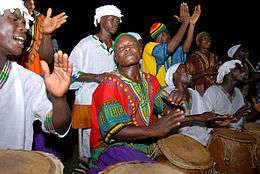Dashiki
The dashiki is a colorful garment for men widely worn in West Africa and also worn in other parts of Africa. It covers the top half of the body. It has formal and informal versions and varies from simple draped clothing to fully tailored suits. A common form is a loose-fitting pullover garment, with an ornate V-shaped collar, and tailored and embroidered neck and sleeve lines.
Etymology
The name dashiki is derived from the Hausa word ʼdan ciki, which means shirt. It is usually worn with a brimless Kufi cap which is worn in Islamic communities in Africa and the African diaspora, and a pair of pants.
History in the West
The dashiki is originally from Ghana but was made popular in the western parts of the world by Oba (Yoruba word for king) Ofuntola Oseijeman Adelabu Adefunmi, who was born Walter Eugene in Detroit, Michigan, USA in 1928. He became interested in African Studies at the age of 16, and traveled to Haiti at the age of 20 in order to be exposed to African religion from indigenous Africans. Soon after, he returned to the U.S. and began a small scale manufacturing business which included African attire, most notably dashikis.
Versions
The informal version is a traditional print or embroidered dashiki. Three formal versions exist. The first type consists of a dashiki, sokoto (drawstring trousers), and a matching kufi. This style is called a dashiki suit or dashiki trouser set and it is the attire worn by most grooms during wedding ceremonies. The second version consists of an ankle-length shirt, matching kufi, and sokoto and is called a Senegalese kaftan. The third type consists of a dashiki and matching trousers. A flowing gown is worn over these. This type is called a grand boubou or an agbada.
There are several different styles of dashiki suits available from clothing stores. The type of shirt included in the set determines the name. The traditional dashiki suit includes a thigh-length shirt. The short sleeve, traditional style is preferred by purists. A long dashiki suit includes a shirt that is knee-length or longer. However, if the shirt reaches the ankles, it is a Senegalese kaftan. Finally, the lace dashiki suit includes a shirt made of lace. A hybrid of the dashiki and caftan worn by females is a traditional male dashiki with a western skirt.
Wedding colors
White is the traditional color for West African weddings.[2] Most grooms wear white dashiki suits during wedding ceremonies.[3] Some couples wear non-traditional colours. The most common non-traditional colors are purple and blue.
- Purple and lavender: the color of African royalty.[4]
- Blue: blue is the color of love, peace, and harmony.
Funeral colors
Black and red are the traditional colors of mourning.[5]
Dashiki in the United States
The dashiki found a market in America during the black cultural and political struggles in the 1960s. The dashiki was featured in the movies Uptight (1968), Putney Swope (1969), and the weekly television series Soul Train (1971). Jim Brown, Wilt Chamberlain, Sammy Davis Jr., and Bill Russell were among the well-known African-American athletes and entertainers who wore the dashiki on talk shows. Hippies also adopted dashikis into their wardrobe as a means to express counterculture values.[6] Former District of Columbia mayor and council member Marion Barry was known for wearing a dashiki leading up to elections.
The term dashiki began appearing in print at least as early as 1967. Reporting on the 1967 Newark riots in the Amsterdam News on July 22, 1967, George Barner refers to a new African garment called a "danshiki". An article by Faith Berry in the New York Times Magazine includes it on July 7, 1968.
"Dashiki" formally appeared in the Webster's New World Dictionary, 1st College Edition 1970/72. It cites J. Benning as having coined the word in 1967. J. Benning, M. Clarke, H. Davis and W. Smith were founders of New Breed, the first manufacturer of the garment in the United States, Harlem, New York. York Wong joined the company as Financial Vice President in 1971.
Dashiki has been found on many musicians mostly the African-American musicians including famous ones like Chris Brown, Beyoncé, Rihanna, Zendaya, ScHoolboy Q, Q-Tip and many more.
See also
| Wikimedia Commons has media related to Dashikis. |
References
- ↑ Labrador, Emilio. https://www.flickr.com/photos/3059349393/3332243434/. Missing or empty
|title=(help) - ↑ "African American Wedding Culture".
- ↑ "African Wedding Dress".
- ↑ "African Wedding Traditions and Culture".
- ↑ "Funerals in Ghana".
- ↑ http://fashion-history.lovetoknow.com/clothing-types-styles/dashiki
Further reading
- Anyiam, Thony C. (2007), Jumping the Broom in Style, Authorhouse, ISBN 1-4259-8638-2.
- Cole, Harriette (2004), Jumping the Broom: The African-American Wedding Planner, 2nd Ed., Owl Books, pg. 117, ISBN 0-8050-7329-9.
- Hoyt-Goldsmith, Diane (1994), Celebrating Kwanzaa, Holiday House, ISBN 0-8234-1130-3.
